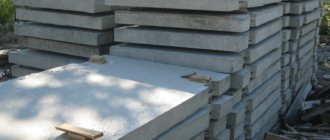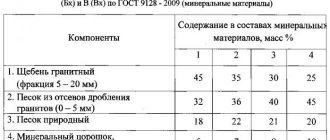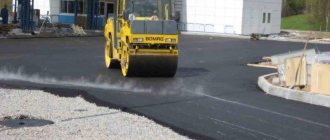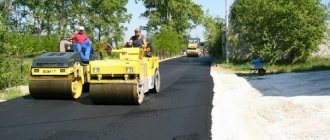We often see potholes, cracks and holes in the road surface. This may be due to both natural wear and tear, as well as incorrect mixture composition and inaccurate calculation of the asphalt compaction coefficient during laying.
The quality of the future road surface depends on many factors. It is necessary to select the optimal mixture composition in accordance with the purpose of the structure, calculate the compaction coefficient of asphalt and soil, prepare the site, configure the equipment, and so on. Weather conditions during work also play an important role.
The compaction coefficient (CU) of asphalt is an indicator that will be individual in each specific case. The value can only be obtained in laboratory conditions.
How is CG calculated?
To determine the coefficient you need to know:
- Average density of the mixture;
- Maximum density.
To begin with, a prototype of the asphalt concrete mixture is taken and its average density is calculated. As we remember from the school curriculum, density is the ratio of mass to volume, that is, it is quite simple to calculate. To obtain maximum density, the mixture is heated and shaped. The last step is a simple mathematical operation: the average density is divided by the maximum, obtaining the compaction coefficient of asphalt concrete.
Composition of the mixture for road surfaces
In fact, asphalt and asphalt concrete (AB) are different things. More precisely, asphalt concrete is a mixture of various inert substances. In other words, it is reinforced asphalt. Since the composition is different, the installation method will also be different.
The basis of asphalt is bitumen. Depending on the purpose of the future structure (it can be not only a road or sidewalk), gravel and sand are added to the bitumen in varying percentages. This is the standard composition. Asphalt itself in its pure form resembles resin and in this form is unsuitable for construction.
AB is a more artificial material; it may contain gravel, crushed stone, sand, and so on. The scope of application of asphalt concrete is much wider.
And it is already becoming clearer that the compaction coefficient of asphalt and asphalt concrete will differ.
In general, asphalt concrete consists of three main components:
- Knitting;
- Stone;
- Mineral.
Bitumen is used as a standard binding component (tar was previously used, but its use was abandoned). Stone includes gravel, sand, crushed stone, and so on. Moreover, not only the quantity in the mixture is important, but also the size and shape. The third component is mineral powders (often from waste from cement plants). Simply put, it is dust that fills the space between large particles of the composition.
Various auxiliary components can also be added to the mixture to strengthen and increase wear resistance.
The compaction coefficient of coarse-grained and fine-grained asphalt also differs.
Compaction of layers of road mixtures during asphalt paving. Rolling asphalt with a roller.
Organization of road works
4 years ago Asphalting Ruza, asphalt laying Ruza, asphalt paving Ruza, asphalt work Ruza, asphalting territories Ruza, asphalt repair Ruza, asphalt crumbs Ruza, road construction work Ruza, patching asphalt, landscaping, laying asphalt crumbs, road repairs, road construction, road repair, road work, road construction, road repair work, road patching, asphalt concrete pavement patching, road patching, asphalt patching, sidewalk patching, asphalt renewal, asphalt pavement repair, laying asphalt chips in SNT, territory development, laying asphalt concrete pavement, asphalting parking lots, asphalting parking lots, asphalting courtyards of high-rise buildings, asphalting garage cooperatives, asphalting industrial sites, asphalting warehouses, asphalting paths in a suburban area, asphalting in the country, asphalting local areas, asphalting streets, asphalting sports sites, asphalting access roads, asphalting parking pockets, road construction, asphalting in production workshops, asphalting parking lots for heavy vehicles, asphalting courtyard areas, asphalting sidewalks, asphalting small areas, asphalting sites, asphalting in SNT, asphalt concrete pavement, asphalting roads, asphalting parking lots, asphalting of car showrooms, asphalting of the territories of enterprises and organizations, asphalting of trenches, usually asphalt paving, laying asphalt in hangars, laying asphalt inside underground parking lots, paving services, laying asphalt inside warehouses, laying asphalt surfaces, asphalt, building roads from asphalt, paving in hard-to-reach places, current repair of asphalt pavement, current repair of road surface, installation of a new asphalt surface, installation of asphalt surface, installation of road pavement, complete replacement of the road surface, replacement of asphalt, road reconstruction, road construction, major road repairs, major road repairs, major repairs asphalt pavement, major repairs of road surfaces, construction of new transport interchanges, comprehensive landscaping, complex construction of highways, construction of a bypass road, construction of new roads, construction of a new road, construction of highways, road repairs, road restoration, construction of dirt roads, installation road base, territory planning, vertical planning, road laying, filling roads with sand, filling roads with crushed stone, laying foundations of sand and crushed stone, concreting the territory, leveling (removing) soil, installing temporary roads, laying roads, milling asphalt concrete pavements, building up necks wells, drainage and stormwater systems, pouring with bitumen or emulsion, processing with bitumen emulsion, laying paving slabs, installing curb (edge) stones, laying paving stones, filling roads with asphalt chips, laying out pavement with asphalt chips, laying out roads with asphalt chips, laying out a lawn, landscaping, laying geotextiles, installation and laying of geogrids, excavation work, digging a pit, soil removal, construction waste removal, asphalt concrete mixture, road workers, asphalt paving team, road construction team, asphalt concrete plant, asphalt plant.
Equipment for compacting asphalt and soil
Obviously, the greater the density of the mixture at the laying stage, the less the road surface is deformed during operation. Nowadays, the choice of equipment for compacting asphalt and soil is wide and allows you to select a unit for a specific type of work. The most effective machines can be called those with a vibrating laying principle. Such machines exert both their mass and vibrations, which significantly reduces operating time and improves quality. Units of the world brand Atlas Copco are represented by a wide range of vibratory rollers, vibrating plates and rammers.
Vibration equipment is compact and maneuverable and shows a high level of performance.
With an accurate calculation of the asphalt compaction coefficient and the correct choice of equipment, the structure will last for many years.
Read more about equipment for asphalt compaction in the article.
Crossfinances
Reducing the energy intensity of the process of compacting crushed stone bases, clinched with asphalt granulate, increasing the density and strength of the constructed layer is achieved by the fact that asphalt granulate is made in special crushing plants from scrap old asphalt concrete obtained from dismantling asphalt concrete pavements of roads, streets, sidewalks, etc., and has an installed and standardized grain composition, allowing the most dense filling of the voids between the crushed stones. The technology for performing work using this material to achieve the required strength of the road base should be as follows. The construction of the crushed stone base of road pavements is carried out in two layers with clinching of each of them with asphalt granulate, which is due to the need to achieve an elastic modulus of the base layer of at least 300 MPa in accordance with the requirements of regulatory documentation. Crushed stone is distributed over the prepared underlying layer and pre-compacted. After this, a one-time distribution of asphalt granulate is carried out over the crushed stone and its leveling with a motor grader. The picker then loosens the asphalt granulate and the upper part of the crushed stone layer, which is necessary for mixing the crushed stone and asphalt granulate and filling the voids in the crushed stone layer with asphalt granulate. Then the layer is leveled and finally compacted with rollers. The use of asphalt granulate makes it possible to fill the voids in crushed stone as much as possible, and the content of a certain amount of bitumen leads to the fact that at the temperature of laying and compacting the asphalt concrete pavement, the bitumen in the asphalt granulate softens, “gluing” the grains of asphalt granulate and crushed stone into a single conglomerate, ensuring their immobility. By filling the voids in the crushed stone layer with asphalt granulate, the density of the base of the road pavement increases, its strength increases, the elastic modulus of the base increases from the initial 280-300 MPa to 320-340 MPa, i.e. by 1.1-1.2 times, which increases the reliability coefficient and durability of road pavements. Another area of research was the solution to the problem of ensuring the evenness of sidewalk surfaces - one of the main problems in the operation of pavements for pedestrian paths made of small-piece tiles. The complexity of solving this problem is due to the fact that the tiled road surface consists of individual elements that are not interconnected, the adhesion between which is achieved only due to the friction forces of the side faces of the tiles, and the evenness of the pavement depends to a large extent on the evenness of the base layer. The pavement bases made of ASG or sand used until now did not allow long-term preservation of the required levelness. This is due to a number of reasons, the main one of which is related to the mechanics of the base layers made of ASG or sand.
The base layer of road pavements made of ASG or sand is a non-cohesive system, which, in addition to large particles that act as a frame, also contains small particles, including dusty and clayey particles. During construction work, the base material is compacted, but the volume of pores and voids remains significant. This is due to the impossibility of using heavy compaction equipment to compact the bases of pedestrian paths, and the use of light rollers and vibrating plates does not allow achieving proper compaction. During operation, the grains of such bases are repacked due to the influx of, for example, rainwater, when small particles are carried out of the base, as a result of which the base loses its shape. On the pavement surface made of small tiles, subsidence and other irregularities form. The method of repairing road pavements by adding sand under sagging tiles does not solve the problem, since in a limited space (one or several tiles) it is not possible to compact the repaired area with the required quality. Thus, the only option for correcting levelness defects until now was the complete reconstruction of the defective section of the sidewalk, which led to unjustified economic costs. To maintain the long-term evenness of sidewalk surfaces, the base of the road pavement must be made of a material reinforced with a binder. The use of traditional binders (bitumen and cement) increases the cost of construction work. As a possible solution to the problem, the use of asphalt granulate as a base material was proposed. During the compaction process, asphalt granulate particles are packed into a dense layer, achieving a layer elasticity modulus of 210-220 MPa. The use of natural ASG and sand makes it possible to achieve a foundation strength of only 180-190 MPa. As can be seen from the comparison, the structural strength of road pavements increases by at least 1.25 times, which increases the reliability and durability of road structures. In addition, during operation, granulated asphalt grains stick together due to the existing bitumen, which makes it possible to obtain a dense and cohesive structural base layer. Due to the bonds formed between the grains of asphalt granulate, the base layer, when operating in normal mode, allows long-term preservation of the original evenness and continuity, which determines the required performance of pavement pavements covered with small-piece tiles.
Go to page: 3
Economic and statistical analysis of labor productivity Labor productivity is one of the most important qualitative indicators of an enterprise's performance, an expression of the efficiency of labor costs. The level of labor productivity is characterized by the ratio of the volume of products produced or work performed and the cost of working time...
Economics in railway transport Calculation of volumetric and qualitative indicators of the operation of cars ...
Method for determining the compaction coefficient of asphalt concrete
01 33/42 STATE PATENT COMMITTEE OF THE REPUBLIC OF BELARUS METHOD FOR DETERMINING THE COMPACTION COEFFICIENT OF ASPHALT CONCRETE (71) Applicant Belarusian State Road Research and Design Technological Institute Dorstroytekhnika Scientific and Production Association Belavtodorprogress (73) Patentee Belarusian State Road Research and Design Technological Institute Dorstroytekhnika Scientific and Production Association Beavtodorprogress (57) A method for determining the compaction coefficient of asphalt concrete, including determining the average density of asphalt concrete and its compaction coefficient, characterized in that the true density of asphalt concrete is additionally determined, and the compaction coefficient is determined by the formula (56) 1. Operational quality control of earthen material canvas and road pavements / Under. ed. AND I. Tulaeva. - M. Transport, 1985. - P. 160. 2. GOST 12801-84. Mixtures of asphalt concrete road and airfield, tar road concrete, asphalt concrete and tar concrete. Test methods. -M. Publishing house of standards, 1984. - P. 34 (prototype). The invention relates to testing road building materials, namely to testing asphalt concrete and determining its compaction coefficient. There is a known method for determining the compaction coefficient of asphalt concrete, based on the correlation dependence of the time of passage of air through the pores of asphalt concrete on its density 1. The disadvantage of this method is the high complexity of establishing correlation dependencies, as well as the complexity of the measuring equipment. The closest to the proposed method is the method of determining the coefficient of compaction of asphalt concrete, including taking samples from the coating (cores or cuttings), determining their average density, manufacturing (remolding) samples from this mixture in the laboratory at a standard load of 2, determining the average density of the remolded samples and calculating the ratio of the average density of coating samples to the average density of remolded samples 2. 3067 1 However, the average density of remolded samples (reference density) is determined at certain fixed loads and loading modes, which does not allow judging in each specific case regarding the value of the obtained and actual maximum density of the sample. The objective of the invention is to increase the accuracy of determining the compaction coefficient and reduce the complexity of testing. This task is achieved by the fact that in the method for determining the compaction coefficient of asphalt concrete, including determining the average density of the sample, the true density of asphalt concrete is additionally determined, and the compaction coefficient is calculated using the formula K - true density of asphalt concrete (asphalt concrete mixture), g/cm 3 required 0. — required residual porosity of asphalt concrete, . The method is carried out as follows. Cutting samples or cores are taken from the asphalt concrete pavement. Three samples with an undisturbed structure weighing 200-400 g are separated from the cutting to determine the average density. Core samples are tested entirely. Before testing, the samples are dried to constant weight. The average density is determined in accordance with standard 2 as the density of asphalt concrete taking into account the pores present in it. Next, from the same mixture, the true density of asphalt concrete is determined by 2, without taking into account the pores present in it. Based on the determination of the average density of asphalt concrete and the true density of asphalt concrete, the compaction coefficient Ku is determined using the formula K, required where 0. — the required value of residual porosity of asphalt concrete, established by standards or by the customer. Example. Determine the compaction coefficient of asphalt concrete road surface, provided that the required residual porosity of asphalt concrete is 0.3. A core sample selected from the road surface is prepared for testing and, in accordance with standard 2, the average density of asphalt concrete is determined, which is equal to 2.45 g/cm 3. From the same asphalt concrete mixture, according to standard 2, the true density of asphalt concrete is determined (2.52 g /cm 3). Consequently, the compaction coefficient of asphalt concrete taken from the coating will be equal to K. The proposed method for determining the compaction coefficient of asphalt concrete is more accurate and less labor-intensive compared to the known method 2. The higher accuracy of the method is ensured by determining the true density of asphalt concrete, i.e. the maximum density achievable for a given asphalt concrete composition. This density does not depend on the method and mode of compaction of asphalt concrete, as is the case in the known method for determining the reference density. The labor intensity of the method is also significantly less due to the fact that there is no need to reshape samples to determine the reference density. Determining the true density of asphalt concrete is much simpler. Thus, to reform a sample and determine its reference density, the labor costs are 8 people/hour, to determine the true density of asphalt concrete - 3 people/hour, i.e., the labor intensity of testing using the proposed method is 2.5 times less than the known one. State Patent Committee of the Republic of Belarus. 220072, Minsk, F. Skorina Avenue, 66.
Skating rink operation. Layer-by-layer soil compaction. How to do it right
When compacting soil, we want to highlight a number of points that are often overlooked.
1. What soil indicator needs to be monitored . In one case, this is the skeletal density of dry soil, in the other, the compaction coefficient.
Let us explain: the skeletal density of dry soil is the ratio of soil mass per unit volume, usually expressed kg/m3 or g/cm3. The soil compaction coefficient is the ratio of the current soil density to the maximum possible density of the same soil (determined according to GOST 22733 in the laboratory), expressed as a number (for example: 0.95; 0.98).
Which indicator needs to be monitored must be specified in the project documentation or established by another document.
2. One of the most important indicators of soil, which is established in the laboratory, is maximum density with optimal humidity . Essentially, this is the soil moisture at which this soil can be compacted to maximum levels. Therefore, the team foremen who supervise the process of layer-by-layer soil compaction must know what moisture content the rolled soil should have. If the moisture content of this soil is more or less than optimal, measures must be taken (either dry or moisten, respectively).
Compacting soil whose actual moisture content differs significantly from the optimal one is incorrect and economically unprofitable, since much more roller passes are required and, as a result, the required soil density may not be achieved.
3. It is necessary to strictly observe the thickness of the rolled layer . The thickness of the layer depends on the type and weight of the roller. If you make layers of greater thickness, the soil may not be compacted to the required level.
4. If the roller leaves a clearly visible mark behind it, then, as a rule, the soil has not yet been compacted; additional penetrations of the roller . If, after thorough compaction with a roller, streaks from the passage of the roller on the ground still remain, this means that the soil being compacted does not have optimal moisture content. In this case, it is necessary to bring the soil moisture closer to optimal (either moisten the soil or dry it).
5. You need to pay attention to the quality and properties of the soil for backfilling. It often happens that the soil purchased and delivered to the construction site turns out to be unsuitable due to its properties. For example, its maximum density at optimal humidity is lower than required, and in principle it is impossible to roll it to the required value.
6. Do not roll the soil during rain . Soil that has absorbed water will not compact properly.
7. Rainy weather and frost can ruin previously rolled layers; they will need to be removed and rolled again.
8. Turn on vibration on the skating rink . This really helps compact the soil. But you need to turn on the vibration after the soil has stopped compacting with the usual passes of the roller.
9. When rolling crushed stone and gravel, use a declinger . That is, pour and roll soil of different grain sizes (different fractions) so that the smaller grains fall between the larger ones. This gives a denser packing of grains, which ultimately increases the density of the soil. For example, when rolling crushed stone of fraction 20-40, add a layer of crushed stone of fraction 10-20 and add and roll a small layer of sand on top.
10. Each compacted layer of soil must be tested by a laboratory . Only after the laboratory confirms that the soil indicator (density or compaction coefficient) corresponds to the required one can the rolling of a new layer begin.









